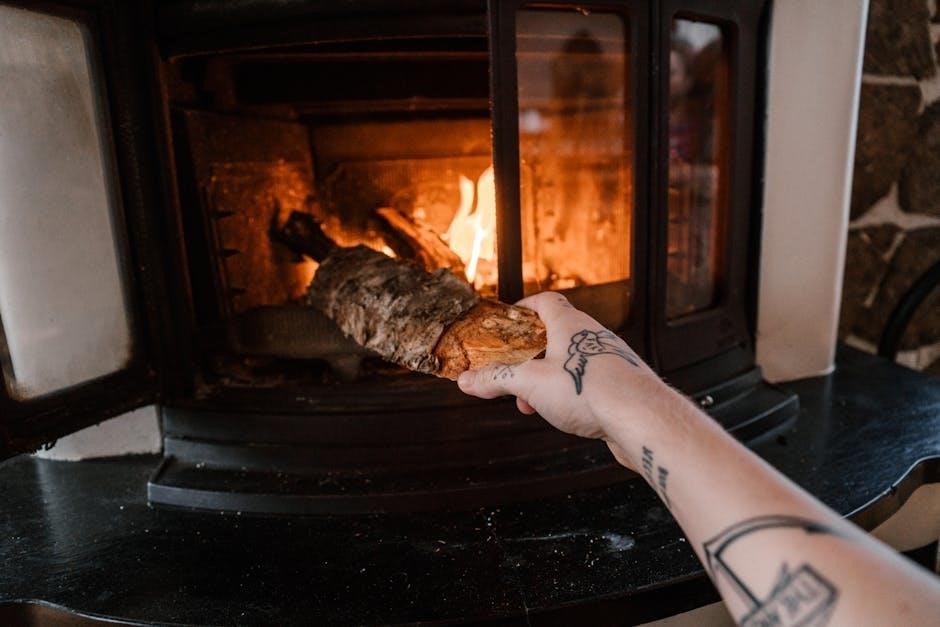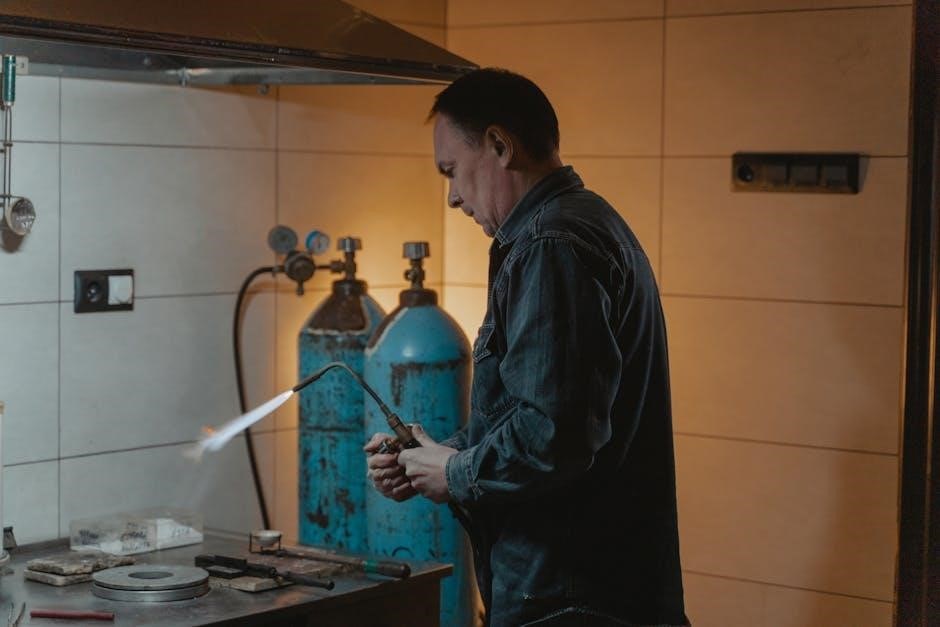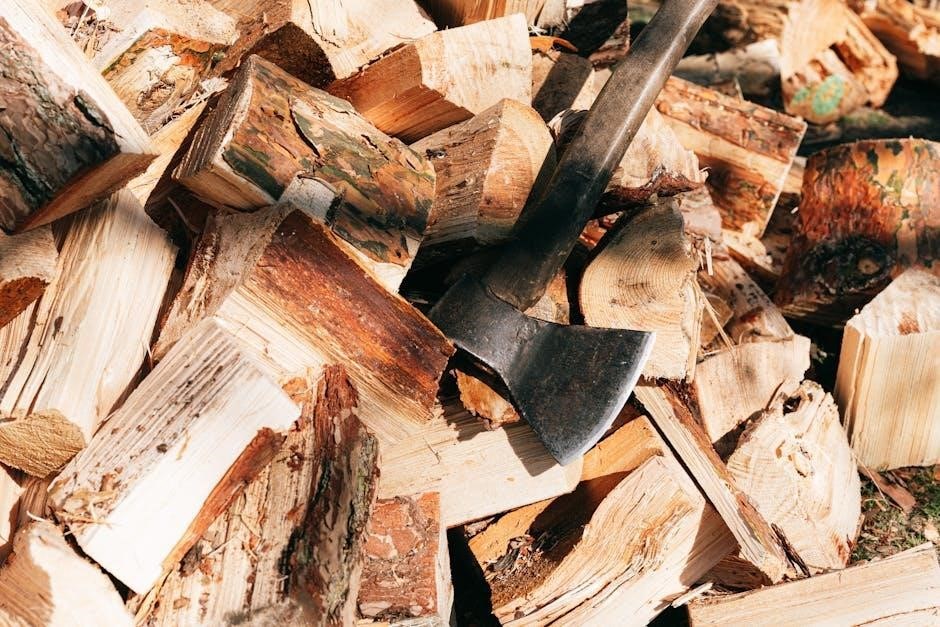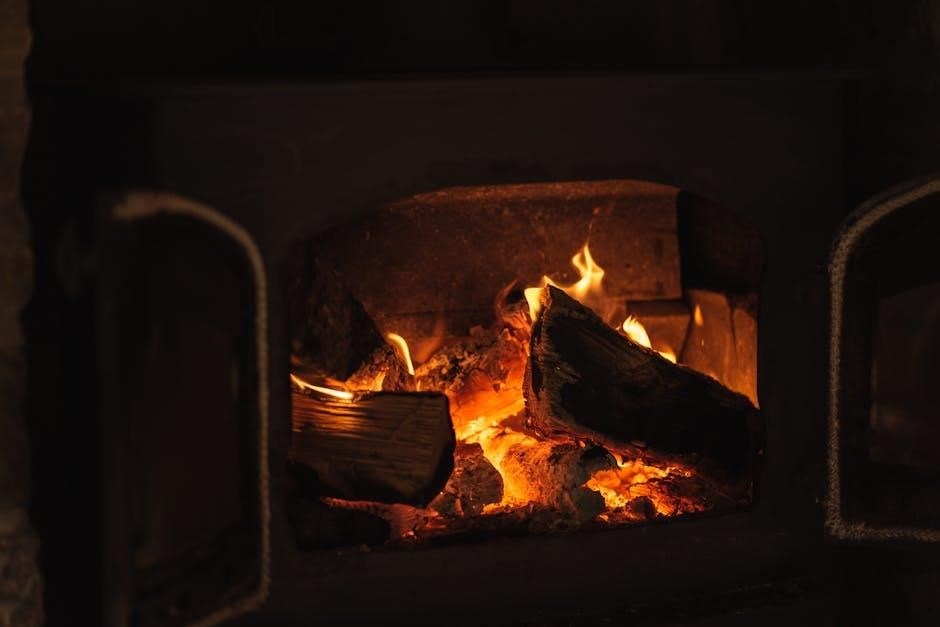
Overview of the Burning Log Turbo 10 Wood Heater
The Burning Log Turbo 10 is a popular Australian-made wood heater, master engineered for long life and low environmental impact. It heats up to 250sqm, featuring a 12mm thick baffle plate and optional turbo mode. Some models double as cookers, demonstrating versatility. Replacing door glass is possible on older (1980-1994) models.
Understanding the Burning Log Turbo 10 Catalyst Stove
The Burning Log Turbo 10 Hi-tec is identified as a catalyst stove, a crucial element in understanding its operational efficiency and environmental impact. Catalyst stoves, like the Turbo 10, utilize a catalytic combustor to reduce emissions and improve overall heating efficiency. This combustor, often referred to as the “cat,” works by lowering the ignition temperature of flue gases, allowing them to burn more completely.
The catalytic combustor essentially acts as a filter, burning off pollutants that would otherwise be released into the atmosphere as smoke. This process results in cleaner emissions and a more efficient burn, extracting more heat from the wood fuel.
Owners should learn to understand the nuances of catalyst stoves, including the importance of proper maintenance and the potential for reduced performance if the catalyst is damaged or clogged. Regular inspection and cleaning of the catalyst are vital to ensure optimal efficiency and minimal smoke production.
Operating a catalyst stove requires a slightly different approach compared to traditional wood stoves. Proper air control settings are crucial to ensure the catalyst reaches its optimal operating temperature. Understanding how to adjust the air controls to achieve a clean, efficient burn is key to maximizing the benefits of the catalytic technology. Familiarize yourself with the stove’s manual for detailed instructions on air control settings and catalyst maintenance.
Identifying Air Control Levers on Older Turbo 10 Models
Older Burning Log Turbo 10 wood heaters, particularly those from the 70s and 80s, often feature two air control levers located above the door. These levers are crucial for regulating the airflow within the firebox, directly impacting the stove’s efficiency and burn quality. Identifying these levers and understanding their function is essential for optimal operation.
Typically, these levers are positioned horizontally and move sideways. One lever usually controls the primary air intake, which feeds air directly into the firebox, influencing the intensity of the fire. Adjusting this lever allows you to control the rate at which the wood burns. The other lever manages the secondary air, designed to improve combustion efficiency by introducing air higher in the firebox, promoting the burning of gases and reducing smoke.
Without a manual, determining the exact function of each lever can be challenging. Experimentation may be necessary to understand how each lever affects the fire. Start with small adjustments and observe the changes in the flame and smoke output. Understanding the interaction between these two air controls is key to achieving a clean and efficient burn.
Remember to consult any available resources, such as online forums or experienced users, for specific guidance on your particular model. Some users may have insights into the specific lever configurations and optimal settings for older Turbo 10 models.

Function of Flaps on the Bottom Front of the Turbo 10
Some Burning Log Turbo 10 models feature flaps located on both sides of the bottom front of the unit. These flaps, often connected to a top lever via a spring mechanism, can be a source of confusion for owners, especially when their purpose isn’t immediately apparent.
Contrary to initial assumptions, these flaps are generally not air inlets. Examination with an inspection camera often reveals that the tubes connected to these flaps do not lead directly into the firebox for air intake. So, what is their function? These flaps are primarily designed for ash control and potentially for directing preheated air into specific areas of the firebox to aid in combustion.
When closed, the flaps help contain ash within the firebox, preventing it from spilling out when the door is opened. This is particularly useful for models with a shallow firebox or those prone to ash buildup. The lever mechanism allows for synchronized opening and closing of both flaps simultaneously.
In some designs, the flaps may also play a role in directing preheated air. Air may be drawn in from the bottom of the unit, heated as it passes around the firebox, and then directed into the combustion chamber via these flaps. This preheated air can improve combustion efficiency and reduce smoke emissions.
To fully understand the function of these flaps on your specific Turbo 10 model, consult any available documentation or seek advice from experienced users. Observing how the flaps interact with the fire during operation can also provide valuable clues.
Preliminary Setup of Air Control Valves
Setting up the air control valves on an older Burning Log Turbo 10 wood heater, especially models from the 70s or 80s with two air control levers above the door, is crucial for efficient and safe operation. This preliminary setup significantly impacts the heater’s performance, burn time, and overall effectiveness. The original instruction book usually covered this procedure, but many owners find themselves without this valuable resource.
Begin by ensuring the firebox is clean and free of excessive ash buildup. This allows for proper airflow and prevents obstruction of the air control mechanisms. Next, identify the two air control levers located above the door. Typically, one lever controls primary air intake, while the other manages secondary air, often related to the catalytic combustor, if present.
The primary air lever regulates the amount of air entering the firebox from below, directly impacting the intensity of the fire. The secondary air lever controls air introduced higher in the firebox, promoting more complete combustion of gases and reducing smoke. Starting with both levers in the fully closed position is generally recommended.
Initiate the fire with a small amount of kindling and gradually introduce larger pieces of wood as the fire establishes itself. Slowly open the primary air lever to increase the fire’s intensity. Observe the flames and smoke output. Adjust the secondary air lever to minimize smoke and maximize heat output. The goal is to achieve a clean, efficient burn with minimal visible smoke exiting the chimney.
Fine-tuning the air control valves may require experimentation based on wood type, moisture content, and desired heat output. Documenting the optimal settings for various conditions can greatly improve future operation.

Finding a Manual for the Burning Log Turbo 10
Locating a manual for an older Burning Log Turbo 10 wood heater can be a challenge, but it’s a worthwhile endeavor for understanding its operation, maintenance, and troubleshooting. Given the age of these stoves, finding an original physical copy might prove difficult, but several avenues can be explored.
Start by contacting local fireplace retailers or service technicians who may have experience with Burning Log heaters. They might possess archived manuals or be able to provide guidance based on their familiarity with the model. Online forums dedicated to firewood, wood heating, or specific stove brands can also be valuable resources. Members may have scanned copies of the manual or be able to offer advice based on their experience.
Searching online auction sites or classifieds for “Burning Log Turbo 10 manual” could potentially yield results. While less likely, it’s worth checking periodically. Another approach involves contacting the manufacturer or its successor, if one exists. They may have digital copies of older manuals available or be able to provide relevant technical information.
If a specific manual remains elusive, consider searching for manuals of similar wood heater models from the same era. The general principles of operation and maintenance are often comparable. Look for manuals that discuss air control settings, damper operation, and troubleshooting common issues like smoke problems.
Finally, create a digital archive of any information you gather, including forum discussions, diagrams, and notes. This will serve as a personalized manual tailored to your specific heater and experiences. Remember to prioritize safety and consult with qualified professionals when in doubt.
Troubleshooting Smoke Issues with a Turbo 10
Smoke escaping from a Burning Log Turbo 10 wood heater can indicate several underlying problems. A systematic approach is essential for effective troubleshooting. Begin by inspecting the chimney to ensure it’s clean and unobstructed. Creosote buildup or debris can significantly restrict airflow, leading to smoke spillage. Consider a professional chimney sweep if necessary.
Next, examine the air intake vents and control levers. Ensure they are fully open to provide adequate combustion air. Insufficient air supply can cause incomplete burning and excessive smoke. Check the door seal for any damage or gaps that might allow smoke to escape. Replace the seal if needed.
The type and condition of the wood also play a crucial role. Use only seasoned, dry wood. Wet or unseasoned wood produces significantly more smoke and reduces heating efficiency. Avoid burning treated or painted wood, as it releases harmful chemicals and contributes to smoke problems.
Observe the damper control lever. It should be positioned to allow proper airflow up the chimney. An improperly adjusted damper can restrict draft and cause smoke to back up into the room. Ensure the damper is opening and closing correctly. Also, consider external factors such as wind conditions or nearby obstructions that might affect chimney draft.
If the problem persists, investigate the catalytic combustor, if your Turbo 10 model is equipped with one. A clogged or damaged combustor can impede airflow and increase smoke production. Consult the manual for cleaning or replacement instructions. If all else fails, seek professional assistance from a qualified wood heater technician to diagnose and resolve the issue safely.

Replacing Door Glass on Older Turbo 10 Models
Replacing the door glass on older Burning Log Turbo 10 wood heaters (specifically those manufactured between 1980 and 1994) is a task that can often be accomplished by a homeowner with basic tools and a bit of patience. Before starting, ensure the stove is completely cool to prevent burns. Gather necessary materials, including a replacement glass pane specifically designed for the Turbo 10, heat-resistant rope gasket, screws, and a screwdriver.
Carefully remove the door from the stove. Place it on a protected surface to avoid scratching the finish. Examine the existing glass retaining frame. Remove any screws or clips securing it to the door. Gently detach the frame, being mindful of any broken glass fragments.
Clean the frame thoroughly, removing any old gasket material or debris. Apply a fresh bead of heat-resistant rope gasket around the perimeter of the frame; This gasket ensures a tight seal and prevents air leaks. Position the new glass pane within the frame, ensuring it fits snugly.
Reattach the glass retaining frame to the door, securing it with the screws or clips. Tighten the fasteners evenly to avoid cracking the glass. Ensure the glass is properly aligned and sealed within the frame. Allow the adhesive or sealant to cure completely before reinstalling the door onto the stove.
Once the door is reinstalled, inspect the seal to confirm there are no gaps. Light a small fire to test the stove and verify that the new glass is functioning correctly. If smoke escapes around the door, readjust the frame or add more gasket material. Regular maintenance and proper glass replacement will ensure the continued safe and efficient operation of your Turbo 10 wood heater.

Locating Spare Parts for Burning Log Heaters
Finding spare parts for Burning Log heaters, particularly the Turbo 10 model, requires a strategic approach due to the brand’s long history and the potential for older models. Start by identifying the specific model and year of manufacture for your heater. This information is crucial for ensuring compatibility with replacement parts. Check the heater itself for any identifying labels or markings.
Begin your search online. Many retailers specialize in wood heater spare parts and maintain websites with extensive catalogs. Use specific keywords, such as “Burning Log Turbo 10 parts,” to narrow your search. Look for reputable dealers with good reviews and clear return policies.
Consider contacting local fireplace and heating specialists. These businesses often stock or can order spare parts for various brands, including Burning Log. They may also have access to older or discontinued parts through their network of suppliers.
Explore online marketplaces and auction sites. While these platforms can offer competitive prices, exercise caution and verify the seller’s reputation before making a purchase. Ensure the parts are genuine or of comparable quality.
When ordering spare parts, double-check the part numbers and descriptions to ensure they match your heater’s requirements. Common replacement parts include door glass, baffle plates, gaskets, and fans. For older models, consider aftermarket or non-original parts if original replacements are unavailable. Verify that the aftermarket parts meet the necessary safety standards.
Keep records of your purchases, including part numbers and supplier information, for future reference. Regular maintenance and timely replacement of worn parts will prolong the life of your Burning Log heater and ensure its continued safe and efficient operation.
Understanding the Damper Control Lever
The damper control lever on a Burning Log Turbo 10 wood heater is a crucial component for regulating the airflow within the firebox and controlling the burn rate of the fire. Understanding its function is essential for efficient and safe operation of the heater.
The damper is typically located at the rear of the firebox and is connected to a lever, often positioned above the door of the heater. The lever moves sideways to control the position of the damper plate. When the lever is moved to one side, it opens the damper, allowing more air to flow through the firebox. Conversely, moving the lever to the opposite side closes the damper, restricting airflow.
The position of the damper directly affects the intensity and speed of the fire. When the damper is fully open, the fire receives a greater supply of oxygen, resulting in a hotter and faster burn. This is useful for quickly heating up a cold room or for burning off excess creosote buildup in the chimney.
When the damper is partially or fully closed, the airflow is restricted, causing the fire to burn more slowly and produce less heat. This is ideal for maintaining a consistent temperature over a longer period, such as overnight.
Proper damper control is also important for safety. Closing the damper too much can lead to incomplete combustion, resulting in the production of carbon monoxide, a dangerous and odorless gas. Ensure adequate ventilation in the room when operating the heater, and never completely close the damper when a fire is burning.
Regularly inspect the damper mechanism to ensure it is functioning smoothly and that the damper plate is not obstructed by debris. A properly functioning damper is essential for efficient and safe wood heater operation.